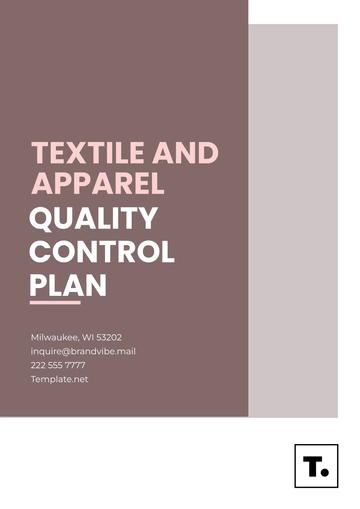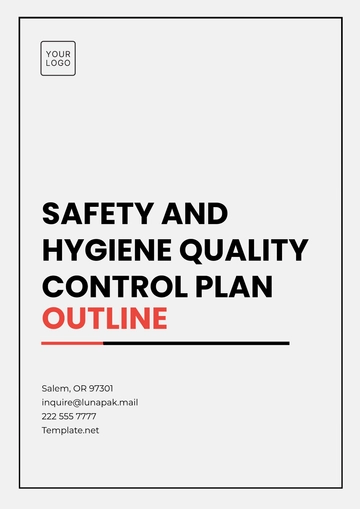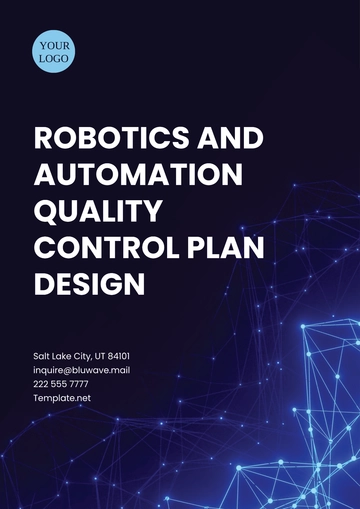Free Aerospace Industry Quality Control Plan

Prepared by:
[Your Name]
[Your Company Name]
1. Introduction
At [Your Company Name], our commitment to quality and safety in aerospace manufacturing is unwavering. The Aerospace Industry Quality Control Plan is meticulously designed to ensure the highest standards are upheld throughout our production processes. This plan encompasses key control measures, detailed personnel responsibilities, and comprehensive protocols to maintain and enhance excellence in aerospace production.
2. Quality Objectives
Our foremost objectives are to achieve zero defects in production, consistently meet and exceed customer specifications, and ensure unwavering regulatory compliance.
2.1. Key Performance Indicators (KPIs)
Defect Rate: Less than 0.5%
Customer Satisfaction Score: Above 95%
Compliance Audits: 100% Pass Rate
2.2. Goals for Continuous Improvement
We are dedicated to continuous improvement through the implementation of a robust feedback mechanism and regularly scheduled review sessions to foster ongoing enhancements in our quality control processes.
3. Quality Control Procedures
3.1. Inspection and Testing
Every product undergoes rigorous inspection and testing at each stage of production to ensure adherence to established quality standards. This includes:
Incoming Material Inspection: Ensuring raw materials meet specifications before entering the production process.
In-Process Inspection: Continuous monitoring and testing during production to detect and correct any deviations.
Final Product Inspection: Comprehensive testing of finished products to verify they meet all quality and safety standards before delivery.
3.2. Documentation and Reporting
We maintain thorough documentation of all quality control activities and results, facilitating seamless auditing and review. This includes:
Inspection Reports: Detailed records of inspections at each stage.
Non-Conformance Reports (NCRs): Documentation of any deviations from quality standards and the corrective actions taken.
Quality Audits: Regular internal and external audits to ensure compliance and identify areas for improvement.
4. Personnel Roles and Responsibilities
Our plan clearly defines roles for each member involved in the quality control process, ensuring accountability and operational efficiency.
4.1. Quality Control Manager
Oversee all quality control operations.
Ensure training and compliance of QA team members.
Report KPIs and quality metrics to upper management.
Develop and implement quality improvement initiatives.
4.2. Quality Assurance Engineers
Conduct inspections and testing at various stages of production.
Identify and address potential quality issues promptly.
Collaborate on process improvements and development of best practices.
4.3. Production Staff
Adhere to quality standards and procedures in daily operations.
Report any quality issues or deviations immediately to the Quality Assurance Engineers.
Participate in ongoing training programs to stay updated with quality protocols.
5. Training and Development
We provide continuous, comprehensive training programs focused on developing the skills and knowledge necessary to adhere to our stringent quality standards. These programs include:
Initial Training: Intensive training for new hires on quality control procedures and standards.
Ongoing Training: Regular training sessions to update skills and knowledge.
Effectiveness Assessment: Regular evaluations of training programs to ensure they are effective and up-to-date.
6. Risk Management
We implement a comprehensive risk management strategy to identify, assess, and mitigate potential quality control risks. This includes:
Risk Identification: Systematic identification of potential risks at each stage of production.
Risk Assessment: Evaluating the likelihood and impact of identified risks.
Risk Mitigation: Developing and implementing strategies to mitigate identified risks.
Regular Reviews: Continuous monitoring and updating of risk registers and contingency plans.
7. Supplier Quality Control
We work closely with our suppliers to ensure high-quality standards in raw materials and components. This includes:
Supplier Audits: Regular audits of suppliers to ensure compliance with our quality standards.
Performance Evaluations: Ongoing performance evaluations to monitor and improve supplier quality.
Collaboration: Working collaboratively with suppliers to address any quality issues and enhance overall quality.
8. Conclusion
The implementation of this Quality Control Plan ensures that [Your Company Name] meets and exceeds industry standards, delivers exceptional products, and continues to advance the frontier of aerospace technology. By maintaining rigorous quality control measures and fostering a culture of continuous improvement, we aim to exceed customer expectations and drive innovation in the aerospace industry.
- 100% Customizable, free editor
- Access 1 Million+ Templates, photo’s & graphics
- Download or share as a template
- Click and replace photos, graphics, text, backgrounds
- Resize, crop, AI write & more
- Access advanced editor
The Aerospace Industry Quality Control Plan Template from Template.net is a fully editable and customizable solution designed to meet the rigorous standards of the aerospace sector. Easily adjust and personalize the plan to suit your project requirements. Editable in our AI Editor Tool, it ensures a seamless, efficient approach to quality control management.
You may also like
- Finance Plan
- Construction Plan
- Sales Plan
- Development Plan
- Career Plan
- Budget Plan
- HR Plan
- Education Plan
- Transition Plan
- Work Plan
- Training Plan
- Communication Plan
- Operation Plan
- Health And Safety Plan
- Strategy Plan
- Professional Development Plan
- Advertising Plan
- Risk Management Plan
- Restaurant Plan
- School Plan
- Nursing Home Patient Care Plan
- Nursing Care Plan
- Plan Event
- Startup Plan
- Social Media Plan
- Staffing Plan
- Annual Plan
- Content Plan
- Payment Plan
- Implementation Plan
- Hotel Plan
- Workout Plan
- Accounting Plan
- Campaign Plan
- Essay Plan
- 30 60 90 Day Plan
- Research Plan
- Recruitment Plan
- 90 Day Plan
- Quarterly Plan
- Emergency Plan
- 5 Year Plan
- Gym Plan
- Personal Plan
- IT and Software Plan
- Treatment Plan
- Real Estate Plan
- Law Firm Plan
- Healthcare Plan
- Improvement Plan
- Media Plan
- 5 Year Business Plan
- Learning Plan
- Marketing Campaign Plan
- Travel Agency Plan
- Cleaning Services Plan
- Interior Design Plan
- Performance Plan
- PR Plan
- Birth Plan
- Life Plan
- SEO Plan
- Disaster Recovery Plan
- Continuity Plan
- Launch Plan
- Legal Plan
- Behavior Plan
- Performance Improvement Plan
- Salon Plan
- Security Plan
- Security Management Plan
- Employee Development Plan
- Quality Plan
- Service Improvement Plan
- Growth Plan
- Incident Response Plan
- Basketball Plan
- Emergency Action Plan
- Product Launch Plan
- Spa Plan
- Employee Training Plan
- Data Analysis Plan
- Employee Action Plan
- Territory Plan
- Audit Plan
- Classroom Plan
- Activity Plan
- Parenting Plan
- Care Plan
- Project Execution Plan
- Exercise Plan
- Internship Plan
- Software Development Plan
- Continuous Improvement Plan
- Leave Plan
- 90 Day Sales Plan
- Advertising Agency Plan
- Employee Transition Plan
- Smart Action Plan
- Workplace Safety Plan
- Behavior Change Plan
- Contingency Plan
- Continuity of Operations Plan
- Health Plan
- Quality Control Plan
- Self Plan
- Sports Development Plan
- Change Management Plan
- Ecommerce Plan
- Personal Financial Plan
- Process Improvement Plan
- 30-60-90 Day Sales Plan
- Crisis Management Plan
- Engagement Plan
- Execution Plan
- Pandemic Plan
- Quality Assurance Plan
- Service Continuity Plan
- Agile Project Plan
- Fundraising Plan
- Job Transition Plan
- Asset Maintenance Plan
- Maintenance Plan
- Software Test Plan
- Staff Training and Development Plan
- 3 Year Plan
- Brand Activation Plan
- Release Plan
- Resource Plan
- Risk Mitigation Plan
- Teacher Plan
- 30 60 90 Day Plan for New Manager
- Food Safety Plan
- Food Truck Plan
- Hiring Plan
- Quality Management Plan
- Wellness Plan
- Behavior Intervention Plan
- Bonus Plan
- Investment Plan
- Maternity Leave Plan
- Pandemic Response Plan
- Succession Planning
- Coaching Plan
- Configuration Management Plan
- Remote Work Plan
- Self Care Plan
- Teaching Plan
- 100-Day Plan
- HACCP Plan
- Student Plan
- Sustainability Plan
- 30 60 90 Day Plan for Interview
- Access Plan
- Site Specific Safety Plan
























